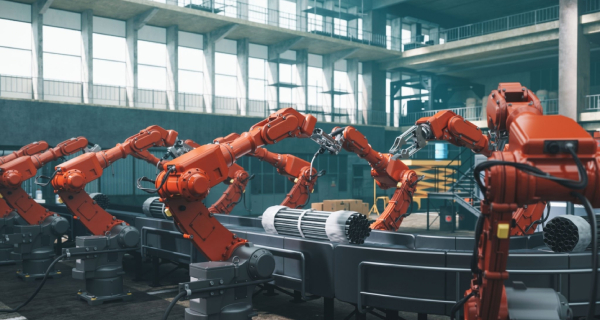Businesses face a critical issue in a fast changing industrial landscape: sluggish growth and losing competitiveness. These difficulties upset leaders as the globe shifts to a new paradigm, raising doubts about the future. The concept of smart manufacturing emerges as a sympathetic reaction to these industry aches. Smart factories are the crucial solution for bridging the past and the future, enabling the dynamic evolution and widespread acceptance of Industrial 4.0. Dive in and let’s examine the complexities of this seismic change.
Understanding the Essence of Smart Factories
Smart factories aren’t merely a trendy term; they are an evolution in manufacturing. Marked by technologies like real-time analytics, self-regulating machinery, and enhanced integration, these factories stand out for their adaptability and exceptional performance. The true essence of a smart factory lies in its autonomous functioning with the flexibility of human oversight.
The genius of smart factories is in their harmonious blend of the digital and physical worlds. Advanced sensors, integral to these factories, feed continuous data into systems. This interconnection offers a new level of orchestration, with machines learning, communicating, and making decisions, all while synergizing with human workers.
Embracing the smart factory model offers businesses an array of compelling advantages. The efficiency gains are significant, with waste reduction, improved output, and proactive maintenance. With the agility to pivot production lines rapidly, companies can respond to market needs promptly. Enhanced connectivity and insights from data make decision-making precise, giving businesses a unique edge in the evolving market.
Key Components of a Smart Factory
The allure of smart factories isn’t just in their futuristic facade or their promise of enhanced efficiency. It’s in the intricate tapestry of technologies that make up their core, each strand weaving together to create a masterpiece of modern manufacturing. Let’s delve into these key components that bring the concept of a smart factory to life. Smart factories thrive on a plethora of advanced technologies:
The Internet of Things (IoT): Making Machines Talk
Machines in smart factories communicate continuously, thanks to the Internet of Things (IoT). From relaying sensor data to optimizing processes, IoT is the linchpin ensuring real-time and smart operations.
Robotics and Automation: Beyond Manual Labor
Robotics in these factories isn’t just about replacing humans. It’s about leveraging precision, consistency, and safety, opening doors to new product innovations.
Artificial Intelligence & Machine Learning: Predictive Operations and Adaptive Manufacturing
Rather than just responding to problems, smart factories predict and preempt them. AI and ML sift through vast data, ensuring that operations are always a step ahead.
Digital Twin Technology: Mirroring the Real with the Virtual
Picture a virtual doppelganger of your factory. Digital Twin Technology does just that, offering a dynamic model that provides insights into operations, streamlining processes, and decision-making.
Integrated Systems and Networks: Ensuring Seamless Communication
The beauty of smart factories is their interconnectedness. Systems communicate flawlessly, thanks to advanced ERP and MES systems, ensuring a factory that’s optimized at every level.
Challenges in Transitioning to a Smart Factories
While the virtues of smart factories are lauded far and wide, the path to their realization is not without hurdles. Understanding these challenges is essential for industries looking to thrive in the age of Industrial 4.0. Navigating this new terrain requires a blend of technology, strategy, and foresight.
Technological Roadblocks and the Need for Advanced Infrastructure
The path to smart manufacturing necessitates more than just the integration of a few high-tech machines. It necessitates a strong and modern infrastructure that can support a wide range of devices, networks, and systems. Many traditional companies are faced with the daunting task of adapting or redesigning their old setups, which is both expensive and time-consuming.
Reskilling the Workforce: Preparing for a New Age of Manufacturing
The shift to smart factories brings with it a change in the roles and responsibilities of the workforce. Tasks once manual may now be automated, demanding a workforce skilled in managing and overseeing these new systems. This transition necessitates comprehensive training programs, fostering a culture of continuous learning and adaptability. The challenge lies not just in reskilling but also in reshaping mindsets for a new era of manufacturing.
Data Security and Privacy Concerns in a Hyper-connected World
Because factories are now linked to larger networks, they constitute possible entry points for cyber threats, emphasizing the importance of strong cybersecurity measures

The Global Impact of Smart Factories
The ripple effect of smart factories and Industrial 4.0 is felt far beyond the confines of the manufacturing floor.
Minimized Waste Production
Smart factories, with their precision-driven processes, ensure that resources are used optimally. Every bit of raw material is maximized, reducing the amount of scrap and waste.
Energy Conservation
These industries can adjust their energy use based on the needs of the hour thanks to real-time monitoring. Advanced sensors and artificial intelligence-driven analytics ensure that machines and systems use only the energy they require.
Adaptive and Predictive Maintenance
That components and machines are fixed or replaced before they break, minimizing potential energy-wasting problems and guaranteeing efficient machine functioning.
Supply Chain Sustainability
Smart factories may optimize their supply chains to ensure that commodities are procured, used, and transported in the most ecologically responsible way possible. This translates to lower transportation emissions as well as a significant reduction in the carbon footprint associated with obtaining and transporting raw materials.
Circular Manufacturing Approaches
Embracing the principles of the circular economy, many smart factories are geared towards recycling and reusing materials. Whether it’s repurposing by-products or recycling waste into new products, these factories are setting new standards in sustainable manufacturing.
Strategies for a Smooth Transition into the Smart Factory Era
Transitioning to smart factories represents a significant change in how businesses operate and produce goods. The promise of improved efficiency, productivity, and adaptability is tempting, but the journey can be complex. For organizations aiming to make this shift, here’s a detailed overview of effective strategies:
Begin with Pilot Programs
- Scope Identification: Identify a specific process or production line as a pilot. This focused approach allows businesses to test, adapt, and perfect their smart factory transition.
- Learning & Adaptation: By starting small, businesses can gather insights, address challenges, and refine their approach. Mistakes made at this stage are less costly and provide valuable learning experiences.
- Scaling Up: Once the pilot program is successful, it can serve as a blueprint for scaling up to other parts of the organization.
Cultivate a Culture of Continuous Learning
- Employee Training
With the introduction of new technologies and processes, workforce training becomes crucial. Continuous education ensures that staff can effectively interact with the new systems and machinery. - Feedback Loops
Implement mechanisms for employees to provide feedback on the new processes. Their hands-on experience is invaluable for making iterative improvements. - Stay Updated
Technology is ever-evolving. Regularly update training materials and courses to reflect the latest advancements and best practices in the industry.
Forge Collaborations and Partnerships
- Public-Private Partnerships (PPPs) These are agreements between government agencies and private-sector companies for the purpose of financing, designing, implementing, and operating projects and services. Through PPPs, businesses can gain access to public resources, knowledge, and financial support that can expedite the transition.
- Industry Alliances Connect with other businesses, even competitors, to share insights, challenges, and solutions. Collaborative efforts can lead to standardized practices that benefit the entire industry.
- Academic Collaborations Partner with universities and research institutions. These entities often have deep insights into the latest technologies and methodologies, providing an edge to businesses in their transition journey.
Holistic Change Management
- Stakeholder Engagement Ensure all stakeholders, from top management to floor workers, are engaged and informed throughout the transition. Their buy-in is crucial for a smooth transition.
- Transparent Communication Clearly communicate the benefits, challenges, and goals of transitioning to a smart factory. This will help manage expectations and reduce resistance to change.
Read Next : Autonomous Supply Chain For Manufacturing 4.0
Looking Ahead: The Future of Smart Factories
As we gaze into the future, technologies like quantum computing and nanotechnology loom large, promising to redefine manufacturing further. Countries vie for leadership in this new era, with giants like Germany and China taking the lead. However, the landscape is dynamic, with shifts in global manufacturing hubs and the potential for new leaders to emerge.
In the narrative of progress, smart factories are more than just a chapter. They are a transformative force, pushing boundaries and redefining what’s possible. As businesses worldwide brace for this revolution, one thing is certain: the future of manufacturing is not just smart; it’s brilliant.
Ready for the Next Evolution? Revolutionize Your Business at Subang Smartpolitan! Subang Smartpolitan is an integrated township development with a smart, green and sustainable concept that implements IoT based technology in every aspect. The digital integration works to improve the city’s community well-being. In essence, Subang Smartpolitan runs on the concept of IR 4.0 and aims for society 5.0 in the near future.

